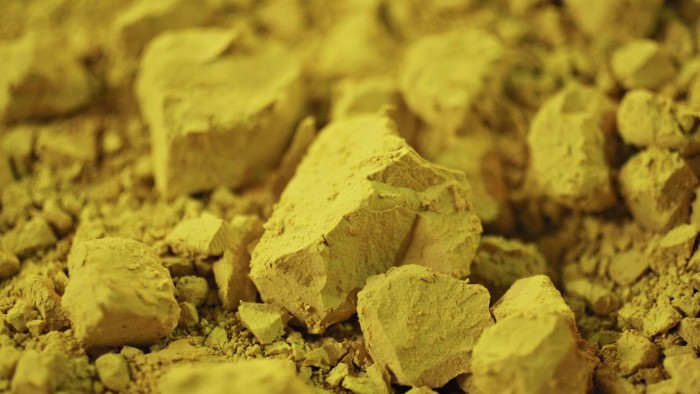Uranium prices hit 12-year high as governments warm to nuclear power

Roula Khalaf, Editor of the FT, selects her favourite stories in this weekly newsletter.
Uranium prices have surged to their highest level in 12 years, underlining a global renaissance in nuclear power as utilities race to lock in fuel supplies.
Prices for the commodity dubbed “yellowcake” have jumped about 12 per cent to $65.50 per pound over the past month, breaching last year’s peak to reach heights not seen since 2011, according to data from UxC, a pricing data provider.
Uranium demand has been lifted by governments from Washington to Seoul and Paris seeking energy independence by extending the lifetime of the existing fleet of nuclear reactors as they contemplate building new plants after gas prices skyrocketed due to Russia’s full-scale invasion of Ukraine.
The milestone for uranium prices marks a big step towards nuclear power’s re-emergence as a critical carbon-free source of baseload power in global efforts to tackle climate change, a role that had been undermined by Japan’s Fukushima nuclear disaster in 2011.
“You have a focus on energy security colliding with a focus on clean energy,” said Grant Isaac, chief financial officer at Cameco, the world’s second-largest uranium producer.
“The days of buying $40 uranium are over — and probably also for $50 or $60. We’re going to need new supplies,” he added.

The pullback in uranium demand and prices following the Fukushima disaster led to a dearth of new mining projects being developed, helping to lay the groundwork for higher prices now.
A coup in Niger, which generates about 4 per cent of the world’s uranium, has added to the upward pressure, as has Cameco announcing in September lower full-year forecasts for production due to challenges at its Cigar Lake mine and Key Lake mill in Canada.
Orano, France’s majority state-owned nuclear company, said last week that shortages of critical chemicals have led its operations in Niger to bring forward planned maintenance.
Prices are still some way off their $73-per-pound level before the Fukushima disaster, which left the uranium market oversupplied for more than a decade after Japan and Germany began decommissioning their nuclear fleets.
Per Jander, director at WMC Energy, a commodity trading merchant, said that the “steady increase” in price was mainly driven by energy utilities, rather than investors.
“There’s a crunch for the next couple of years,” he said. “Not only are we going back to pre-Fukushima levels, we are exceeding it,” he added, referring to the pace of nuclear developments globally led by China.
Just last week, the World Nuclear Association, an international trade body, raised its forecasts significantly for nuclear power’s contribution to worldwide electricity generation and uranium demand.
It estimates that more than 140 reactors could operate longer than previously expected and 35 gigawatt hours of small modular reactors could be developed by 2040, requiring new mines to be developed to meet uranium’s demand doubling to 130,000 tonnes annually.
The nuclear fuel supply chain has been rocked by Russia’s war in Ukraine, since the aggressor nation plays a vital role in the conversion and enrichment of uranium.
“There’s been an imbalance between supply and demand for some time, and it has now been exacerbated by geopolitics,” said Nick Lawson, chief executive of Ocean Wall, a brokerage, who predicts that the uranium spot price could rise to $200 per pound by 2025.
Comments